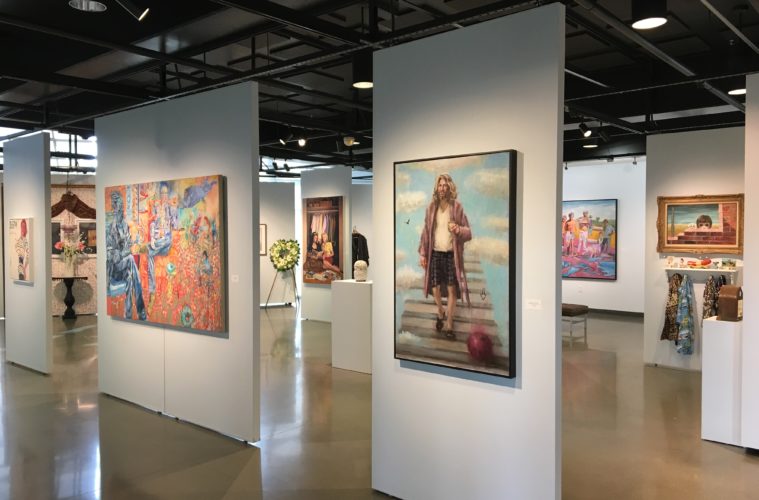The fine art world has been at odds with the concept of kitsch since the 1920s; however, the complicated relationship fine art has with kitsch today is nuanced, in part thanks to the growing variety and popularity of lowbrow art and culture. “Kitsch” is the German word for trash and is used in English to refer to particularly cheap, vulgar and sentimental forms of popular and commercial culture or art. In 1939, the American art critic Clement Greenberg defined kitsch in his famous essay “Avant-Garde and Kitsch” and examined its relationship to the high art tradition as continued in the 20th century by the avant-garde, defining and mandating the perception of kitsch for the entire art world. Greenberg saw kitsch as the opposite of “high art,” but starting around 1950 artists began to take a serious interest in popular culture, resulting in the explosion of pop art in the 1960s. In the 20th century, with the rise of industrialization, kitsch has become associated with mass approved commodities or cheap and poorly refined entertainment. We see kitsch much more frequently today in art, and because of the “so bad it’s good” appreciation, the term does not hold the same negative connotation it once did. The exaggeration of cuteness, of extravagance, or of the playful juxtaposition between high art and low art together are ways in which we see kitsch explored in fine art today.

Photo by Evan Senn
In Coastline Community College Art Gallery’s newest exhibition, curated by artist Bradford J. Salamon, the gallery explores and honors kitsch and its complicated relationship with fine art today. With 47 different artists in “Kitsch-In-Sync” at Coastline, viewers are able to see kitsch in a variety of forms and expressions in art, both positive and negative. This exhibition also explores the role of taste-maker and art critic, calling into question how we determine what is “good” art or “bad.”
In our media-saturated culture, artists are inundated with imagery, from the banal to the extraordinary. Although many artists today try to avoid unintentional artistic influence from the media or other artists, it is unavoidable for most on some level. Imagery can be influential without permission, and the trend of infusing kitsch into fine art is not accepted across the board. This simultaneous disgust and appreciation of kitsch in art is a fascinating visual debate to witness. The subtle exploration and pursuit of balance between kitsch and real taste is an always ongoing quest for contemporary artists working today, and is so slight that sometimes it can be difficult to see what is kitsch and what is not.
In the exhibition at Coastline, we are presented with a wide range of feelings and thoughts on kitsch. Through painting, drawing, installation, sculpture and photography we see how many different faces kitsch has, and how the kitsch in pop culture and in media can be influential, nostalgic and can become significant influence for artists. Through the art on display, we can see how this concept of kitsch has existed in the past – haunting artists and critics alike – and how it is shaped today, infusing elements of kitsch into our contemporary lives in every facet, even in high-brow art.
In “Kitsch-In-Sync,” we see sexuality explored and offset by oppressive traditions of the church, overbearing gender stereotypes and conservative cultures. We see false pop culture idols like Banksy, the Oscar Mayer Weinermobile and Margaret Keane worshiped like gods, placed on pedestals and recreated in extravagant and beautiful fashion. We see “the art critic” compared to a “caveman” (furthering comment on popular culture with reference to Mel Brooks), and historic artists made fun of as if they were plagues on the canon of art history. We see color and form stretched and pushed to their limits and recreations of famous artworks subtlety (and playfully) undermining the authority of the art institution and the history of art.

Photo courtesy of Coastline Community College Art Gallery
The tenets of art have traditionally been broken down into three categories of high-brow art, middle-brow art and low-brow art, complacently corralling viewers of art into categories that shamelessly refer to people as being smart, not-so-smart or straight-up dumb. Luckily, since Robert Williams’ incited lowbrow renaissance, these terms are not as offensive as they once were and are now simply descriptive and sometimes endearing. The traditional fine art world has been elitist since its inception, keeping the masses feeling uneducated and out of the loop with regards to fine art, but lower-brow art allows people of all education levels and of all backgrounds to understand and appreciate art. In “Kitsch-In-Sync,” we see the good, the bad and the hilarious gathered together to explore the idea of taste in art and how beauty truly is in the eye of the beholder.
Some artistic highlights from the exhibition include a black velvet painted balloon dog, an oversized high heel made of resin and full of fuchsia dildos, a realistic portrait of Thomas Kinkade, an altar to Margaret Keane, and fascinating skeletal sculptures resembling Banksy rats, dead. There are pink flamingos referenced, big-busted bikini-clad women, a painting of women exploring the female form by way of playboy magazines, a menorah with Chinese lucky kitties with light-up eyes and mechanical waving paws, and an idolizing installation dedicated to the Madonna Inn. The work on view in this exhibition doesn’t leave any corner of kitsch unturned.
With such a stellar roster of artists and thought-provoking artworks on display, “Kitsch-In-Sync” is a refreshing peek into the complex relationship between kitsch and fine art and an insightful glance at how a range of contemporary artists working today feel about different iterations of kitsch.
Advertising disclosure: We may receive compensation for some of the links in our stories. Thank you for supporting Irvine Weekly and our advertisers.

